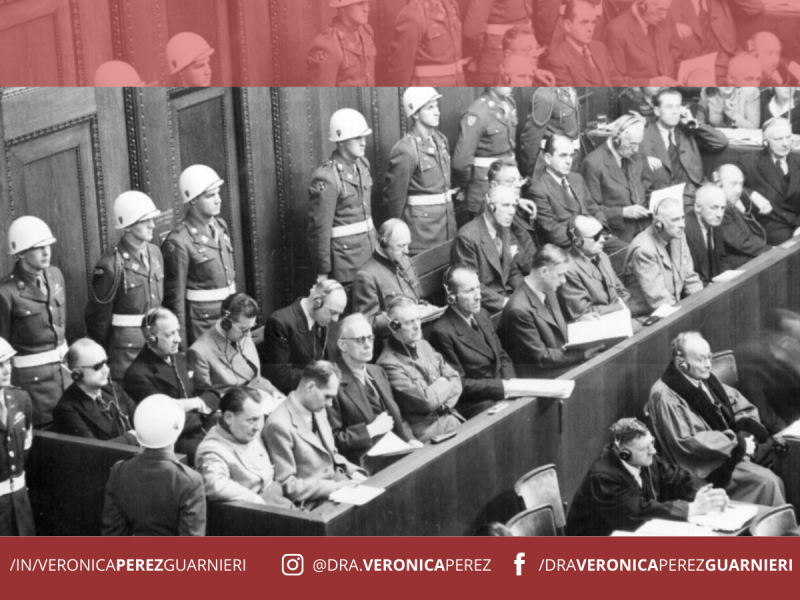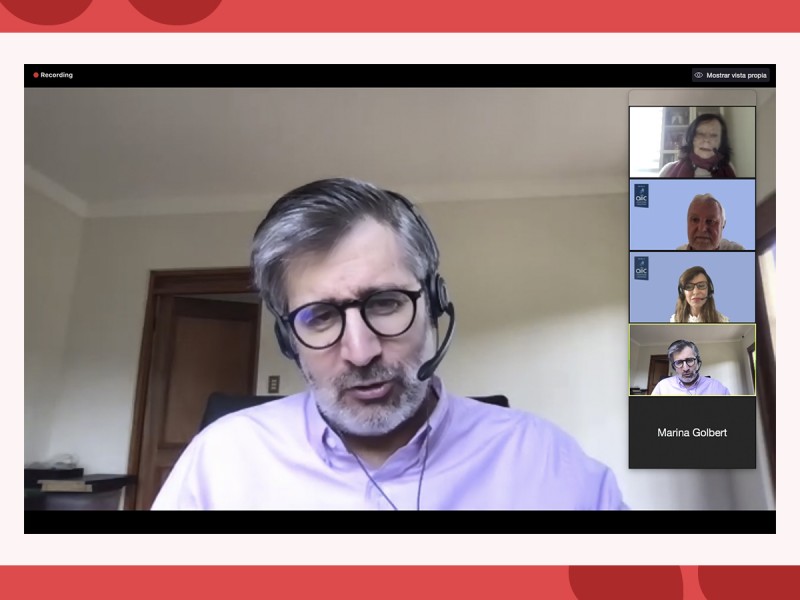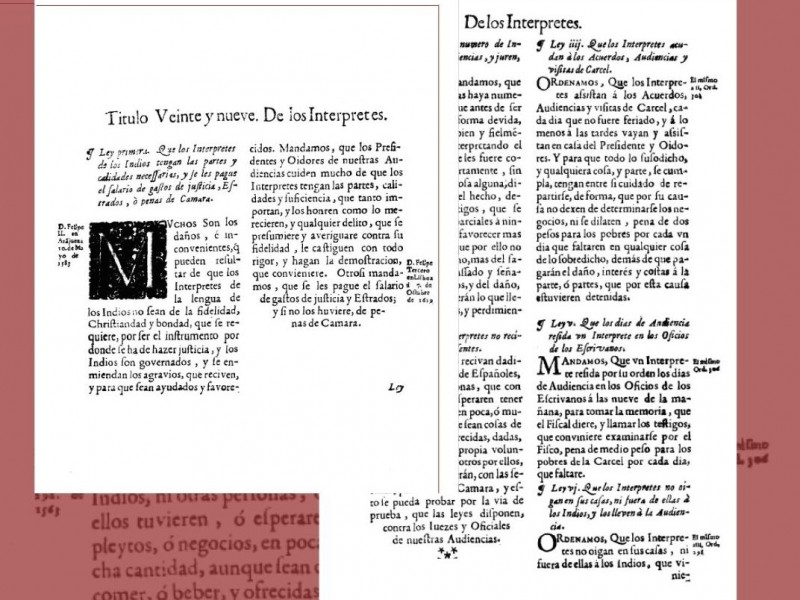Fueron testigos de un hecho histórico que delineó un nuevo rumbo para el mundo. Relatos vívidos de meses donde se repasaron las más dolorosas acciones y se proyectaron imágenes descarnadas de los delitos más aberrantes, frente a frente con los ejecutores impasibles.
El 20 de noviembre de 1945 empezó el juicio que en palabras del fiscal jefe de Estados Unidos, Robert H. Jackson, significaba: «Que cuatro grandes naciones, eufóricas por la victoria y laceradas por la afrenta, refrenen su venganza y entreguen voluntariamente a sus enemigos cautivos para ser juzgados por la ley, es uno de los tributos más significativos que el poder haya rendido jamás a la razón»(The National WWII Museum, 2020).
El 1 de octubre de 1946 el Tribunal Militar Internacional formado por representantes de Estados Unidos de América, Rusia, Inglaterra y Francia hizo público el veredicto del proceso contra los dirigentes nazis acusados de «crímenes de guerra». Al finalizar el juicio, 12 fueron condenados a morir en la horca, pero solo se ejecutaron 11. Goering se suicidó antes de cumplir su pena.
Ver con los propios ojos
Cronista de una época, la argentina Victoria Ocampo, fue invitada por el British Council a presenciar dos audiencias en Nüremberg (La Nación Revista, 2021) (2). En las cartas que envió a sus hermanas describió con una profundidad que duele: «Las fotos son horribles. Montañas de anteojos tirados. Bolsas de pelo de mujer (siete kilos). Los desperdicios de la jabonería: cabezas cortadas y despojadas del cuero cabelludo. Mujeres desnudas corriendo. Otras que las van a fusilar. Chicos llorando. Mal rayo los parta. Y qué tupé tienen todavía».
Testigo voluntaria, Victoria describió un Hermann Goering «pálido, sin rastros de agitación, con un uniforme que corresponde a una pasada corpulencia y privado de los habituales esplendores, descubro ironía en su rostro y actitud». Hess «me recuerda a los monitos que en los días de invierno se acurrucan, desamparados, junto a los barrotes de la jaula». Observa un Keitel «muy despierto, muy alerta. Un rostro duro, descarnado, firme».
Durante la experiencia, ella emite su propio juicio: «Comprendí en esta ciudad lo que es vivir en un país de vencidos. Sólo los vencedores pueden hacerse una gloria de una ruina. Entre los vencidos, ruina es sinónimo de humillación». (Belluci, 2020) (3)
El ejército de la interpretación
Los juicios involucraban los idiomas inglés, francés, ruso y alemán. Esto requería un medio técnico nuevo para poder llevar adelante una interpretación multilingüe de manera rápida. Así surge la interpretación simultánea. El coronel americano Leon Dostert –quien había trabajado como intérprete de Eisenhower–, consiguió idear un sistema basado en un equipamiento de IBM diseñado por Edward Filene y Gordon-Finlay, que se conoció como el Sistema Hushaphone Filene-Finlay. (AIIC) (4)
En Nüremberg había, para cada idioma, un equipo de seis intérpretes, doce traductores y nueve taquígrafos. Un equipo de traductores auxiliares quedaba a la espera de otros idiomas, como por ejemplo, el polaco y el yiddish. El juicio se realizaba a una velocidad de dictado de 60 palabras por minuto. Si el hablante iba demasiado rápido, se encendía una luz amarilla en el monitor. Cuando era necesario que se detenga y repita lo que había dicho, se encendía la luz roja. (American Experience) (5)
Voces femeninas en el proceso
Las mujeres representaron el 20% del total de intérpretes en los juicios, especialmente entre los de habla rusa. Tatjana Stupnikova trabajaba como intérprete del ejército y hablaba muy bien el alemán. Por esta razón fue convocada, casi sin previo aviso, para participar en este hecho histórico. Consciente de la importancia de la misión, Stupnikova relata en sus Memorias: «El trabajo nos exigía sin excepción alguna toda nuestra fuerza física y psíquica. No se trataba solo de condenar a criminales, sino de la revelación de la ideología y la política nacionalsocialistas, de hacer visible su esencia a todos nosotros y de dejar constancia a las siguientes generaciones».
Sin duda, una experiencia difícil pero enriquecedora profesionalmente. Así lo reconoce en sus propias palabras: «Para un intérprete novel de simultánea no hay nada mejor que la práctica continua, con los auriculares en la cabeza y el micrófono en la mano. No podría haber ninguna iniciación mejor a la profesión que Nüremberg». (Kalashnikova) (6)
Reportaje histórico
La prensa del mundo tenía los ojos puestos en Nüremberg y en su justicia ejemplificadora. En primera persona, el corresponsal del «Daily Herald», Maurice Fagence describió una a una las sentencias. «Cuando Goering entró en la sala para oir la sentencia –era el primero– hizo teatro en los más terribles minutos de su vida. Tal vez quería mostrar a los jueces cuán superhumanamente desinteresado estaba respecto a cualquier cosa que hicieran con él». (Lewis, 2012) (7)
La crónica relataba el momento en el que el juez estaba por dictar veredicto y el acusado lo interrumpió afirmando que no funcionaban los auriculares. Luego de varios intentos y de reemplazar el equipo no tuvo más opción que escuchar las palabras «condenado a muerte en la horca». «Goering, el hombre que ordenó los bombardeos de Londres, y que ahora había de morir, lanzó una mirada de desprecio al tribunal, se volvió mesuradamente sobre sus talones y salió por la puerta. Los guardianes sostienen que nunca, mientras ellos escucharon, los auriculares dejaron de funcionar», explicaba el periodista.
Mientras se sucedía la lectura de las sentencias, uno a uno los acusados presentaban una actitud diferente. Y las palabras eran siempre impactantes: «De las primeras cinco sentencias, había cuatro de muerte. Unos murmullos interrumpían el silencio del tribunal», describía Fagence en su artículo. Siguió Rudolf Hess, que «con un feroz manotazo rechazó los auriculares que se le tendían, y se enfrentó al estrado, con las piernas rígidas, separadas, y las manos cruzadas. Encarcelamiento de por vida. Se lamió los labios, y salió casi marcando el paso, ruidosamente con las botas que llevaba cuando bajó en paracaídas en Escocia», rememoraba el observador.
Así fueron desfilando, desde el filósofo Alfred Rosenberg, que al escuchar la condena «se agita como si no lo esperase, se tambalea ligeramente, y sale con la cabeza baja». El caza-judíos Streicher que «tira sus auriculares sobre la mesa con ruido, y sale, en una especie de arrebato de indignación». Hasta que finalmente, «se da sentencia contra un banco vacío: es el de Martín Bormann, sentenciado a muerte en ausencia». Otros dos dirigentes que habían huído eran Adolf Eichmann y Joseph Mengele. Lamentablemente, los principales responsables del Holocausto, Adolf Hitler, Joseph Goebbels, Heinrich Himmler y Reinhard Heydrich estaban muertos.
De unas 4 850 peticiones de procesamientos individuales, en Nüremberg se acusó, finalmente, a 611 personas. Entre los personajes destacados el tribunal dictó 12 condenas a muerte. De forma simultánea, los intérpretes debieron traducir las sentencias en los cuatro idiomas: «To death by hanging» (inglés), «Tod durch den strang» (alemán), «Kazn cherez poveschenie» (ruso) y «Condamné à la pendaison» (francés). (Gavaldá, 2019) (8)
Fuentes
(1) “The Grave Responsibility of Justice: Justice Robert H. Jackson's Opening Statement at Nuremberg.” 2020. The National WWII Museum. Retrieved from: https://www.nationalww2museum.org/war/articles/robert-jackson-opening-statement-nuremberg
(2) “Victoria Ocampo, la cronista de Núremberg”. 2021. La Nación Revista. Retrieved from: https://www.lanacion.com.ar/la-nacion-revista/victoria-ocampo-la-cronista-de-nuremberg-nid05032021/?R=85da75
(3) Belluci, M. 2020. Victoria Ocampo en Nuremberg: a 75 años de los históricos juicios a los jerarcas y militares nazis. Retrieved from: https://latfem.org/victoria-ocampo-en-nuremberg-a-75-anos-de-los-historicos-juicios-a-los-jerarcas-y-militares-nazis/
(4) AIIC. Orígenes de la Interpretación. Retrieved from: https://aiic.org/site/es/profesion/historia
(5) Simultaneous Interpretation at Nuremberg. American Experience. Retrieved from: https://www.pbs.org/wgbh/americanexperience/features/nuremberg-interpretation/
(6) Kalashnikova, E.(June 11). The Nuremberg Trials wouldn’t have taken place without interpreters. Retrieved from: https://en.nuremberg.media/eyewitnesses/20210611/187065/The-Nuremberg-Trials-Wouldnt-Have-Taken-Place-Without-Interpreters.html
(7) Lewis, J.E. (2012) Voices from the Holocaust. United Kingdom: Robinson. Retrieved from: https://books.google.com.ar/books?id=gD2eBAAAQBAJ&pg=PT154&lpg=PT154&dq=maurice+nuremberg++fagence&source=bl&ots=0AHRL_2RtZ&sig=ACfU3U2KNT-gZe6LgdnkystyNcp9noO0nw&hl=es-419&sa=X&ved=2ahUKEwjL8LeWsanxAhUPppUCHfu0DMAQ6AEwDXoECBIQAw#v=onepage&q=maurice%20nuremberg%20%20fagence&f=false (8) Gavaldá. J.2019. El final de los juicios de Núremberg contra los dirigentes Nazis. The National Geographic. Retrived from: https://historia.nationalgeographic.com.es/a/final-juicios-nuremberg-contra-dirigentes-nazis_14755



